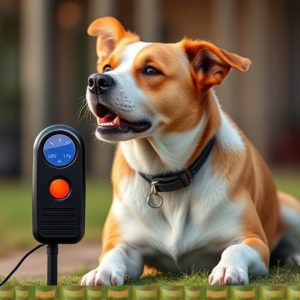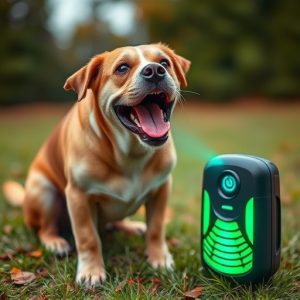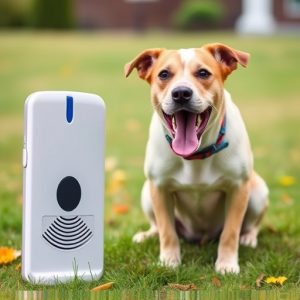Dog Repellent Devices: Science, Safety, & Effective Training Techniques
Dog repellent devices utilizing ultrasonic technology have gained popularity for modifying canine be…….
Dog repellent devices utilizing ultrasonic technology have gained popularity for modifying canine behavior by emitting inaudible sound waves to humans but effective for dogs. Dog Repellent Device Compliance Testing is crucial to ensure these devices meet safety standards and deliver on their promises, guaranteeing effectiveness, humane use, and well-being of both pets and users. The science behind ultrasonic behavior modification leverages specific frequencies tailored to capture canine attention without causing harm, while compliance testing verifies safe sound levels, consistent performance in real-world conditions, and adherence to frequency, intensity, and duration standards. Responsible pet ownership requires adhering to guidelines and using these devices with gradual exposure and positive reinforcement techniques for effective behavior modification.
“Unleash the power of positive training with Dog Repellent Devices, especially those utilizing ultrasonic behavior modification. This comprehensive guide explores how these innovative tools can transform your dog’s behavior. From understanding the science behind their functionality to navigating crucial compliance testing for safety and efficacy, we delve into practical considerations for successful implementation. Learn how to effectively train your canine companion while addressing unwanted behaviors.”
- Understanding Dog Repellent Devices and Their Functionality
- The Science Behind Ultrasonic Behavior Modification
- Compliance Testing: Ensuring Safety and Efficacy of Dog Repellent Devices
- Practical Considerations for Training and Implementation
Understanding Dog Repellent Devices and Their Functionality
Dog repellent devices, often employing ultrasonic technology, have gained popularity as tools for modifying canine behavior. These devices emit high-frequency sound waves that are inaudible to humans but can effectively deter dogs from unwanted actions. Understanding how they work is crucial when considering their use. Compliance testing plays a vital role in ensuring these devices meet safety standards and deliver on their promises.
By subjecting dog repellent devices to rigorous testing, manufacturers can guarantee their effectiveness and safety. This process involves evaluating the device’s ability to emit consistent ultrasonic levels within the target range for dogs while also assessing any potential harm to humans and other animals. Compliance testing ensures that these tools are not only reliable but also humane, providing pet owners with a safe and effective solution for modifying their dog’s behavior without causing discomfort or distress.
The Science Behind Ultrasonic Behavior Modification
The science behind ultrasonic behavior modification involves using sound waves to create a subtle yet effective deterrence for dogs. These devices emit high-frequency sounds, often above the human hearing range, that are specifically designed to capture a dog’s attention and modify their behavior. The technology is based on understanding canine perception and sensitivity to certain frequencies, which can be harnessed to train and discipline pets without causing them harm.
Compliance testing for dog repellent devices is crucial to ensure they remain effective and safe. These tests involve rigorous evaluations to verify the device’s ability to emit consistent ultrasonic tones within regulated decibel levels. By adhering to strict standards, manufacturers guarantee that their products not only meet expectations but also contribute positively to responsible pet ownership.
Compliance Testing: Ensuring Safety and Efficacy of Dog Repellent Devices
Dog Repellent Device Compliance Testing plays a pivotal role in ensuring the safety and efficacy of ultrasonic behavior modifiers used in dog training. These tests are designed to verify that the devices emit sounds at safe levels, effective for modifying behavior without causing harm or discomfort to the animal. By subjecting products to rigorous standards, manufacturers can guarantee their devices meet the required criteria for frequency, intensity, and duration of ultrasound emissions.
Compliance testing involves a series of evaluations that mimic real-world scenarios. This includes assessing the device’s performance under various conditions, such as different power settings, environmental factors like temperature and humidity, and potential interference from other electronic sources. The goal is to ensure the dog repellent device operates reliably and consistently, providing effective behavior modification without any adverse effects on the dog’s well-being.
Practical Considerations for Training and Implementation
When it comes to practical considerations for training and implementing a dog repellent device, such as an ultrasonic behavior modifier, ensuring safety and effectiveness is paramount. It’s crucial to adhere to guidelines and standards set by relevant authorities, particularly regarding Dog Repellent Device Compliance Testing. This includes rigorous testing of the device’s sound output levels to guarantee they fall within safe limits for dogs’ hearing without causing harm or distress.
Additionally, training should involve gradual exposure to the ultrasonic stimuli in controlled environments, starting at low intensities and progressively increasing as the dog demonstrates understanding and compliance. Consistency is key; regular practice sessions using positive reinforcement techniques will reinforce desired behaviors more effectively than punishment methods. Always prioritize your dog’s well-being and comfort during the training process.
Dog repellent devices, especially those utilizing ultrasonic technology, offer a safe and effective solution for modifying canine behavior. Understanding their functionality and scientific basis is key to successful implementation. Rigorous compliance testing ensures these devices meet safety standards and deliver desired results. When properly trained and used, dog repellent devices can revolutionize pet management, fostering a harmonious relationship between humans and their four-legged friends.


